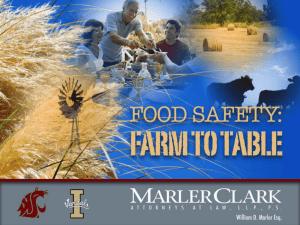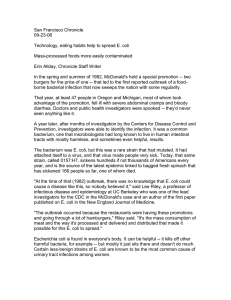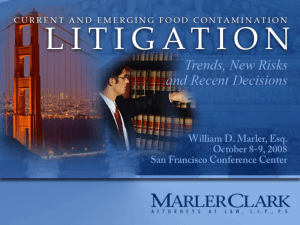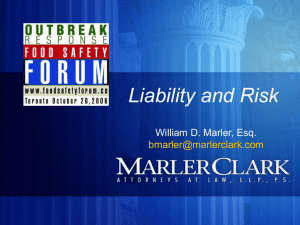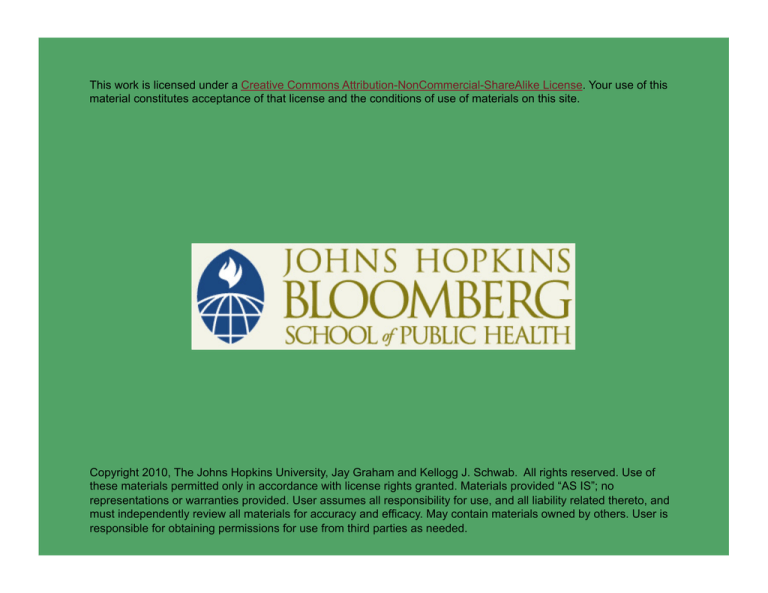
This work is licensed under a Creative Commons Attribution-NonCommercial-ShareAlike License. Your use of this
material constitutes acceptance of that license and the conditions of use of materials on this site.
Copyright 2010, The Johns Hopkins University, Jay Graham and Kellogg J. Schwab. All rights reserved. Use of
these materials permitted only in accordance with license rights granted. Materials provided “AS IS”; no
representations or warranties provided. User assumes all responsibility for use, and all liability related thereto, and
must independently review all materials for accuracy and efficacy. May contain materials owned by others. User is
responsible for obtaining permissions for use from third parties as needed.
Section F: Case Examples
Kellogg J. Schwab, PhD
Johns Hopkins University
Field Assessment of Microbial Load in Swine Waste
Swine CAFO
Photo by Friends of Family Farmers via flickr.com. Creative Commons BY-ND.
3
Swine CAFO Housing Conditions
4
Swine CAFO Effluent Sampling
5
Levels of Microorganisms in Swine Lagoon Waste
Levels of microorganisms in swine lagoon waste
Fecal coliforms
8.8 x 106 per liter
E. coli
Enterococci
1.0 x 107 per liter
5.2 x 106 per liter
A lagoon can hold up to 100 million liters of effluent …
Fecal coliforms
2.2 x 1014 per 108 liters
E. coli
Enterococci
2.5 x 1014 per 108 liters
1.3 x 1014 per 108 liters
6
Antibiotic-Resistant Enterococci: Swine Lagoon Waste
Erythromycin
69%
Approved for nontherapeutic use in swine
Tetracycline
85%
Vancomycin
0%
Never approved for use in
swine in the U.S.
7
2006 Multi-State Spinach E. coli O157: H7 Outbreak
Swine photo by Yu vis flickr.com; Creative Commons BY-ND-SA. Spinach photo by Gaetan Lee vis flickr.com; Creative
Commons BY. Cow photo by Dennis Marciniak via flickr.com; Creative Commons BY-NC-SA.
8
Lettuce and Spinach
21 E. coli outbreaks since 1995
- At least 1,000 reported illnesses and 7 deaths
Fresh or fresh-cut lettuce or spinach implicated as outbreak vehicle
Eight outbreaks traced back to produce from Salinas, California
Source: Marler, W. D. (2007). E. coli 2007: Understanding, detecting and preventing. Urgent one day
conference, February 15, 2007, slide 1. MarlerClark, Attorneys at Law, LLP, PS. Retrieved from http://
www.marlerblog.com/2007%20Spinach.ppt#371
9
E. coli Outbreaks
Lettuce from all three outbreaks came from California’s Salinas
Valley
-
July 2002—Washington dance camp
50 dance campers sickened, several hospitalized, one with
life-long kidney damage
“Pre-washed” lettuce
-
September 2003—California restaurant
40 patrons ill
Salads prepared with bagged, “pre-washed” lettuce
-
October 2003—California retirement center
13 residents sickened, two died
“Pre-washed” spinach
10
2006 Spinach E. coli Outbreak Timeline
September 5, 2006: cluster of five E. coli O157:H7 cases
- Livestock at Manitowoc county fair suspected
September 7: report of five adults with hemolytic uremic syndrome
(HUS) who had undergone plasma exchange
-
E. coli O157:H7 confirmed in three patients
September 8: Wisconsin State Laboratory of Hygiene (WSLH) post
PFGE pattern of eight isolates on PulseNet
-
Seven had indistinguishable patterns, one a small variation
Source: Wisconsin State Laboratory of Hygiene (WSLH).
11
2006 Spinach E. coli Outbreak Timeline
September 7–9: 12 more E. coli O:157:H7 samples received at WSLH
September 11: DPH questionnaires indicate a high percentage of
females and a link with spinach consumption
September 12: Oregon investigation suggests six patients with
E. coli O157:H7 linked to spinach
September 14: CDC confirms 50 cases in eight states
-
-
Wisconsin, New Mexico, Utah, Oregon
One death—77-year-old Wisconsin woman
September 14: conference call with CDC, state HDs, and FDA
- FDA issues advisory for consumers not to eat bagged spinach
Source: Wisconsin State Laboratory of Hygiene (WSLH).
12
2006 Spinach E. coli Outbreak Timeline
September 15: National Selection Foods of San Juan Bautista,
California, recalls all products containing spinach (use-by dates from
August 17 to October 1)
September 19: New Mexico confirms E. coli from patient’s open bag
of spinach
-
-
Identical PFGE pattern to outbreak strain
Other states later identify outbreak strain in bags of spinach
Thirteen bags from eight states, including two from
Wisconsin
September 20: 2-year-old Utah boy dies
October 5: elderly Nebraska woman dies
Source: Wisconsin State Laboratory of Hygiene (WSLH).
13
2006 Spinach E. coli Outbreak: Statistics
205 cases
- 26 states
-
1 Canadian province
Approximately 50 percent hospitalized (104)
Hemolytic uremic syndrome (HUS) (n = 31; 17 percent)
- Higher than usual
39 percent of children
10 percent of adults
Three deaths
14
Reporting Timeline
Best = 6 days
Worst = 23 days
Source: Wisconsin State Laboratory of Hygiene.
15
Spinach Outbreak Strain
E. coli O157:H7 identified as EXHX01.0124 strain
- Accounts for less than 1 percent of strains reported each year
-
Produces only Type 2 shiga toxin
Usually more virulent than strains that produce only Type
1 or both toxins
16
What Was the Source?
Extensive environmental sampling
- Water
-
-
-
Processing plant
Cattle feces
Wild pig feces
17
2006 Dole E. coli Outbreak
E. coli O157:H7
- Isolated from 13 packages of Dole spinach
-
“DNA fingerprints” of all 13 match the outbreak strain of ill
people
-
Same strain found on one of four farms that supplied spinach
to a single manufacturing facility on a particular day—cow
feces, water source, and wild pig gut
18
FDA Definition of Adulterated, 2005
FDA cited research linking some or all of the outbreaks to sewage
exposure, animal waste, and other contaminated water sources
FDA considers “adulterated” any ready-to-eat crops produced under
unsanitary conditions §402(a)(4) of the Food, Drug, and Cosmetic Act
“In light of continuing outbreaks associated with fresh and freshcut lettuce and other leafy greens, particularly from California,
we are issuing this second letter to reiterate our concerns and
to strongly encourage firms in your industry to review their
current operations (2005)”
19
2006 Taco Bell and Taco John’s E. coli Outbreaks
At least 150 sickened in seven states
- Dozens hospitalized
-
Several HUS cases
Two outbreaks separated by a few weeks
Different suppliers and growers
Lettuce grown in California
20
How Do We Prevent Future Outbreaks
Preventive measures
- At the field
Irrigation water
Proximity to cattle, pig, and other animal ranches
Farm worker access to portable toilets and hand washing
facilities
At the processing plant
Decontamination steps
-
-
-
Distribution
Maintaining appropriate temperatures
Consumer education
21

